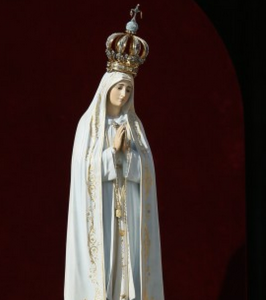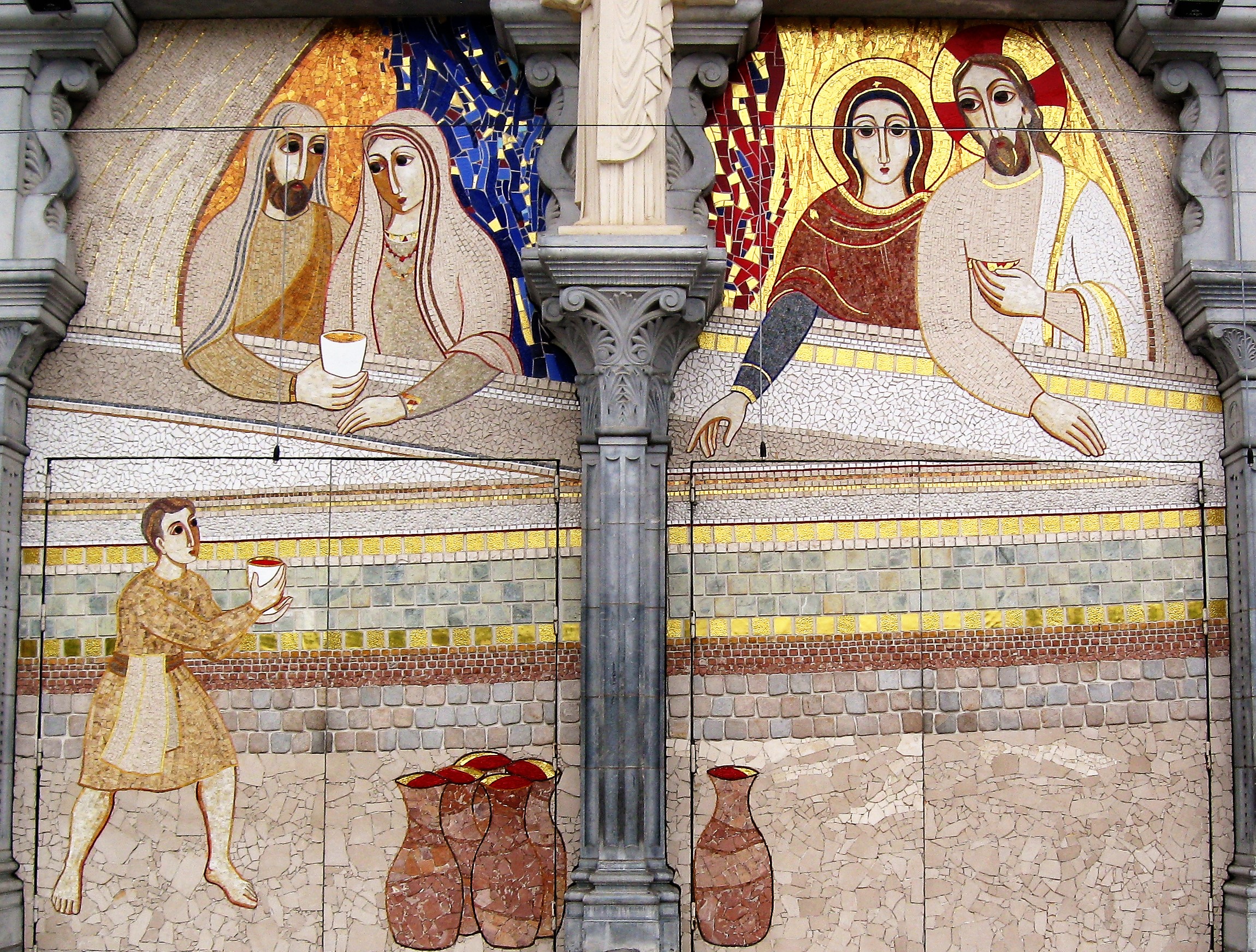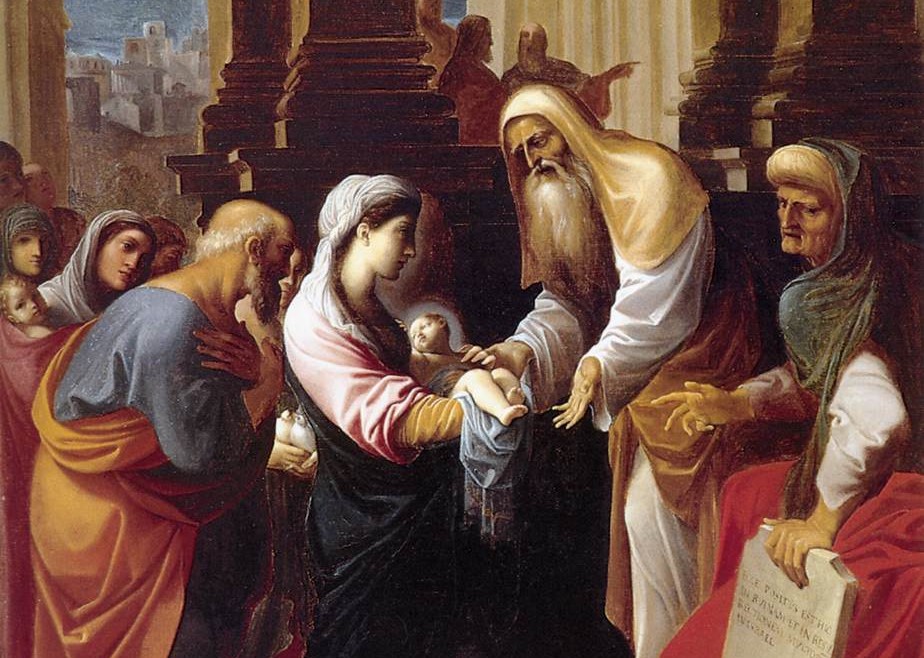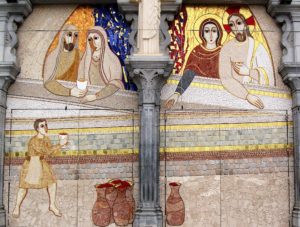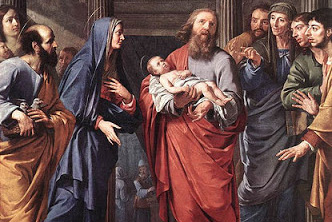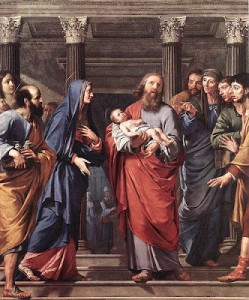In the Gospel for this Fourth Sunday of Advent, we step back nine months to March 25th, the feast of the Annunciation, an all-but-hidden event that changed the world. God, whose focal presence departed the Temple just prior to the Babylonian invasion (cf Ez 10:18) and the loss of the Ark of the Covenant, now returns to the ark of Mary’s womb. The glorious presence of God returns now to His people, in an obscure town of fewer than three hundred, a town so small that no road led to it.
We are reading here of a pivotal moment in the history of mankind. God not only returns to His people but also becomes one with them in the Incarnation.
We do well to consider four aspects of this crucial moment. As we do so, we consider not only Mary’s glories but ours as well (in a subordinate yet real way). Mary is the perfect disciple and her glories typify in a most excellent way the glories that God wishes to bestow upon us, though in a different but still substantial way. Let’s look at four aspects of this Gospel.
I. The RESPECT of God – The text says, The angel Gabriel was sent from God to a town of Galilee called Nazareth, to a virgin betrothed to a man name Joseph and the virgin’s name was Mary … Mary said “Behold, I am the handmaid of the Lord. May it be done to me according to your word.”
Note that God asks Mary for her cooperation. Although the angel Gabriel’s words are not delivered in the form of a question, it is clear from Mary’s response that she considers this to be a request from God. She says yes, understanding it as a request rather than merely a statement of what shall be.
Here we see an important indicator of God’s respect for Mary’s freedom. Surely He has prepared her and equipped her with every good grace to say yes, but in the end her freely offered yes is significant. It is something that God seeks and respects. Otherwise, why would He bother to send an angel at all? Why would He come through Mary at all? Why not simply appear suddenly as a full-grown man and start to work? As it is, God wills to come through Mary (cf Gen 3:15) and seeks her yes in the place of Eve’s no.
God’s respect for Mary’s freely offered yes also extends to us. Indeed, we can see here how God’s respect is in direct contrast to the behavior of the devil, who provokes, shouts, and intrudes. Through cultural noise and other avenues, Satan tempts and provokes us. God, however, whispers and respectfully invites. He does not force a decision on us but rather summons us in love and then patiently awaits our answer.
In Scripture we read this of Jesus: Behold, I stand at the door and knock; if any one hears my voice and opens the door, I will come in to him and eat with him, and he with me (Rev 3:20). Hence, although all-powerful and able to coerce, God does not do so; He does not act violently or impose His will. He respects the freedom He Himself gave us and invites us to cooperate in His plan for us.
God respects Mary’s and our freedom; He “needs” us to open the door for Him to go to work.
II. The Revelation of God – Note the great love, appreciation, and regard that God extends to Mary through the angel. The text says, Hail, Full of grace! The Lord is with you … Do not be afraid, Mary, for you have found favor with God.
Gabriel reveals Mary’s sinless state. Mary is surely God’s masterpiece, the result of His grace and work. She is sinless by being “full of grace.” Filled with grace, she has no room in her for sin.
In his greeting, Gabriel speaks to Mary’s dignity and perfection: Χαιρε κεχαριτωμενη (Chaire, Kecharitomene) (Hail, full of grace). Kecharitomene (full of grace) is a perfect, passive participle indicating an action completed (perfected) in the past but still operative in the present. Thus Gabriel salutes her not by her name, “Mary,” but in a different way: “Hail to her who was perfectly graced and is so now!” Mary had been freed of all sin in the past. She was and is perfectly, fully graced. Gabriel greets Mary and regards respectfully the work of God in her.
In a less perfect (but still true) way, God also loves us and loves in us the perfection we will one day attain by His grace and mercy. A couple of texts come to mind:
-
- I have loved you with an everlasting love; I have drawn you with loving kindness (Jer 31:3).
- Fear not, for I have redeemed you; I have summoned you by name; you are mine. For I am the LORD, your God, the Holy One of Israel, your Savior … you are precious and honored in my sight, and … I love you (Isaiah 43:1-3).
God does not love us because we are good. Rather, God loves us and then if we accept His love we are good. Mary was, by a singular grace, wholly open to God’s love and perfection. If we are faithful, each of us will one day become the man or woman God has always intended us to be.
God shows great regard for Mary (through Gabriel) and also knows the glory we will one day share.
III. The RIDDLE in the middle – There remains Mary’s mysterious question: “How will this be since I do not know man?” Had she been thinking in biological terms she would have known the obvious answer to the question: she and Joseph would conceive. But her question implies that she had other notions about her future than regular marital relations.
Some contend that the question does not really come from Mary, but rather is a rhetorical question or literary device placed here by Luke so that the angel can inform us, the readers, that God alone is the true Father of the Son. Such a notion seems more like the concoction of nervous moderns attempting to solve the mystery. Reducing a pivotal question like this to a mere literary device seems unbecoming.
A better solution is to explore the ancient tradition that there is a backstory supplied to us in the Protoevangelium of James. This is a brief text from the early Second Century that focuses on the infancy and early years of both Mary and Jesus. While not a book of scripture, the text provides an important historical of how the early Church and Christians understood these early events. It also helps to solve the “riddle” of Mary’s question “How shall this be since I know not man?” The text explains that Joseph was an older widower and appointed by the High Priest as a kind of guardian for Mary who was a consecrated virgin who had lived and worked in the Temple. Here are some verses:
And Anna said: As the Lord my God lives, if I beget either male or female, I will bring it as a gift to the Lord my God; and it shall minister to Him in holy things all the days of its life….And her months were fulfilled, and in the ninth month Anna brought forth. And she said to the midwife: What have I brought forth? And she said: A girl….and [Anna] called her name Mary….And the child was three years old…she, [with Joachim and Anna] went up into the temple of the Lord. And the priest received her, and kissed her, and blessed her, saying: The Lord has magnified your name in all generations. In you, on the last of the days, the Lord will manifest His redemption to the sons of Israel. And he set her down upon the third step of the altar, and the Lord God sent grace upon her; and she danced with her feet, and all the house of Israel loved her….And Mary was in the temple of the Lord as if she were a dove that dwelt there, and she received food from the hand of an angel. And when she was twelve years old there was held a council of the priests, saying: Behold, Mary has reached the age of twelve years in the temple of the Lord. What then shall we do with her? And they said to the high priest: You stand by the altar of the Lord; go in, and pray concerning her; and whatever the Lord shall manifest unto you, that also will we do.
And behold an angel of the Lord stood by him, saying unto him: Zacharias, Zacharias, go out and assemble the widowers of the people, and let them bring each his rod; and to whomsoever the Lord shall show a sign, his wife shall she be. And the heralds went out through all the circuit of Judæa, and the trumpet of the Lord sounded, and all ran.
And Joseph, throwing away his axe, went out to meet them; and when they had assembled, they went away to the high priest, taking with them their rods. And he, taking the rods of all of them, entered into the temple, and prayed; and having ended his prayer, he took the rods and came out, and gave them to them: but there was no sign in them, and Joseph took his rod last; and, behold, a dove came out of the rod, and flew upon Joseph’s head. And the priest said to Joseph, You have been chosen by lot to take into your keeping the virgin of the Lord. But Joseph refused, saying: I have children, and I am an old man, and she is a young girl. I am afraid… [But the high priest said], “And now fear the Lord, O Joseph…And Joseph took her into his keeping. (Protoevangelium 8-10)
This back-story provides a context for Mary’s unusual question. Catholic tradition sees evidence in her question of the doctrine of Mary’s perpetual virginity.
In the end, Mary’s question seems to point to some expectation on her part that she would “not know man” going forward. We are not going to be able to completely satisfy our curiosity in this matter and ultimately it is none of our business.
One thing is sure: the Church teaches, without ambiguity, that Mary remained ever-virgin. It seems reasonable to conclude that Mary’s question indicates that she was clear on this. There remains also an element of mystery that we must respect.
Protestants and others who deny Mary’s perpetual virginity have some thinking to do. Mary’s question is neither meaningless nor naïve. Ancient Christianity as evidenced by the Protoevangelium of James already had an understanding of Mary’s perpetual status as a consecrated virgin and saw Mary’s question as a true question with a true context and it ought to be respected as at least pointing to her virginity even if it does not prove it.
IV. The REASSURANCE of God – Mary is in the presence of an archangel. This alone is frightening enough, but in addition her world is shifting dramatically. Hence, her fear and anxiety are understandable. Gabriel gives Mary a number of reassurances: Do not be afraid Mary, for you have found favor with God … Behold you will conceive in your womb and bear a son and you shall name him Jesus. He will be great and will be called the Son of the most high, and the Lord God will give him the throne of David his father, and he will rule over the house of Jacob forever, and of his Kingdom there will be no end …
In effect, Gabriel is telling Mary that however the details unfold, there will be total victory in the end; she is to bear a son, who is the Son of the most High God and who will have a kingdom that will never end or be conquered. In spite of any concerns she has, this will all lead to victory.
Mary will need this reassurance for there are some difficult days ahead: homelessness at the time of Jesus’ birth, the flight to Egypt, Simeon’s prophecy that a sword would pierce her heart, and the actual thrusting of that sword while she is at the foot of the cross. This knowledge of ultimate victory is an important reassurance for her to hold close.
It is an important reassurance for us as well. We, too, have some difficult valleys to cross, some arduous hills to climb. We must constantly keep in mind the end of the story: Jesus is the victor. Even if we might think that we are losing, total victory belongs to Jesus in the end and to us if we stay with Him. The conclusion of the story is already declared: Jesus wins, overwhelmingly. All of His enemies will be placed under His feet (e.g., Rev 20-22; 1 Cor 15:25-26; John 16:33 inter al).
Consider this magnificent passage from Isaiah:
I am God there is no other. At the beginning I foretell the outcome; in advance, things not yet done. I say that my plan shall stand. I accomplish my every purpose. Yes, I have spoken, I will accomplish it; I have planned it and I will do it. Listen to me you fainthearted, you who seem far from the victory of justice: I am bringing on my justice, it is not far off, my salvation shall not tarry; I will put salvation within Zion, and give my glory to Israel (Isaiah 46:12ff).
If we were to memorize and internalize this passage, so many of our fears and anxieties would flee; our trust would build and we would live victorious lives. At times it may seem that evil has the upper hand, but God has the ultimate victory. No matter how dark it may appear at any given time, God has already won; it’s just that the news has not yet leaked out.
This truth and reassurance must be emblazoned on our hearts, for like Mary, we have difficult days in our future. All the more reason that God’s reassurance is essential for us. It got Mary through the cross and it will get us through our trials.
Hence, we have here a pivotal moment in history, when God’s presence returns to the human family. And it all happens so quietly, in Nazareth, a town so small that there was not even a road that led to it. Quietly, but clearly and powerfully, He has thrust the first blow at Satan’s realm. God’s Victory is certain.


